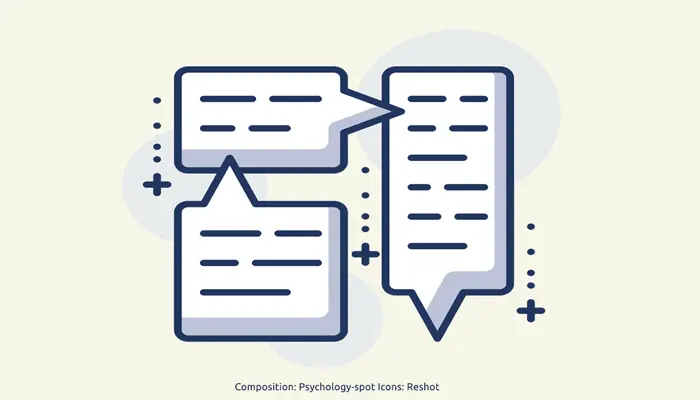
In recent times, it seems that the world is more divided than ever. Opinions are fragmented and polarized, forcing us to take sides. And the more extreme points of view become, the more elusive understanding becomes. In this context, but also in our family, work and social relationships, constructive disagreement can become the way to avoid further tension and unrest while we build the bridges necessary to move forward.
What is constructive disagreement?
Constructive disagreement is a type of disagreement in which two or more people express different points of view with the aim of improving, better understanding the situation or finding a more effective solution for everyone. Unlike destructive disagreements, which often fuel personal conflict or defensive and even aggressive attitudes, constructive disagreement is characterized by an attitude of respect, openness and collaboration.
This approach allows the parties involved to share opposing ideas or perspectives without turning those differences into a personal confrontation. The key? Instead of trying to “win” the argument, we should focus on the shared goal, the common ground, the search for a solution, or the attempt to improve. This attitude broadens the perspective of both parties and leads to personal or even social growth.
How to put constructive disagreement into practice?
It is inevitable that disagreements will arise in relationships because we are all different people. In fact, these differences can even be healthy and developmental as they allow us to learn more about ourselves and the others. However, when there is no willingness to understand, these disagreements can become worse, generating dissatisfaction and frustration on both sides, activating latent conflicts and preventing us from resolving pressing problems. What to do?
1. Break molds and stereotypes
The image we form of our interlocutor will determine the direction of the discussion. A study conducted at the University of Pennsylvania revealed that many people misinterpret disagreements as a sign of poor listening. In other words, we believe that those who disagree with us are “bad listeners.” On the other hand, we value more positively the listening ability of those who agree with us, whom we see as more pleasant, available and even fun.
However, to practice constructive disagreement we must get rid of that “halo effect.” In other words, we need to understand that differences do not make the other person better or worse, just different. Disagreement is not because the other person “does not listen,” but simply because we both see the problem from a unique perspective. If we do not make these value judgments and do not rush to form a stereotypical image of the other person, we will be more open to listening and reaching an agreement.
2. Keep an open mind
People often engage in arguments just to reinforce their point of view or convince others of their position. However, this attitude is counterproductive as it unleashes a confrontational dynamic that hinders communication, collaboration and the exploration of diverse perspectives, missing valuable opportunities to learn. Instead, it is essential to keep an open mind.
An interesting psychological experiment found that when people are given the choice between two interlocutors who disagree with their views (one who wanted to persuade them and one who wanted to learn from them), most people prefer the interlocutor who was willing to learn. This suggests that we like to be listened to with an open mind, so we should listen with an open mind too.
To practice constructive disagreement, then, we must be willing to consider different perspectives, even if they initially clash with our beliefs and values. We must also speak from a place of curiosity, with a willingness to learn and delve deeper into the other person’s perspectives and motivations to truly understand their points of view.
3. Clarify expectations before speaking
When disagreements arise, most people tend to become defensive, forming opinions about each other and letting stereotypes and assumptions flood their minds. In such cases, each interlocutor becomes an impregnable fortress.
To avoid this, it is essential that before addressing the issue in question we make our intentions clear and share our expectations. For example, seeking only emotional support is not the same as asking for advice or simply exchanging ideas before making an important decision. This will help the other person to know what we expect from them. And the other person will also be able to know what to expect from us.
Before presenting our point of view, it is helpful to acknowledge differences in perspective and express a genuine interest in understanding the other person. This will set the tone of the conversation, leading it towards more constructive ground where the goal is to learn from each other or solve a problem, rather than simply win an argument.
4. Find common ground to build bridges
Although more developmental discussions involve differing opinions, it is important to look for common ground from which to build agreement. When we focus on similarities, rather than highlighting differences, we create a more collaborative environment.
Not only does this attitude ease tensions, it also allows each party to recognize the value of the other’s perspective. Instead of seeing the interlocutor as an adversary, we can view him or her as a potential ally in the search for better solutions for everyone.
In fact, a study conducted at Harvard and Stanford universities revealed that we are 50% more likely to discuss sensitive topics with someone if we believe they have the psychological tools necessary to discuss them in a mature manner.
Starting by identifying shared values or goals can be a good starting point for productive dialogue. We can also ask open-ended questions that facilitate the exploration of ideas, rather than trying to fit the richness of human thought into a simple “yes” or “no.” When we tap into those areas of agreement, we not only close gaps and get closer to each other, but we also find it easier to find solutions that incorporate broader perspectives.
5. Focus on the ideas, not the person
At the heart of constructive disagreement is the fundamental premise that the focus should be on the issue at hand and not on the person presenting a different opinion. That distinction is crucial, as personal attacks can divert attention from the real challenge at hand.
Constructive disagreement should always focus on ideas. Personal attacks such as the ad hominem fallacy are not allowed . That means we must have the maturity to separate the person from the issue and construct reasonable arguments, backed by facts or that follow a logical thread.
By focusing on the argument, rather than criticizing people, we can maintain a respectful and productive conversation. For example, instead of saying “you’re wrong” or “you have no idea,” we should say “I understand your position, but I think that…”. Often, this subtle change in language is used to avoid the other person becoming defensive and to make them more willing to listen.
This dynamic not only strengthens interpersonal relationships, but also enriches the decision-making process, as we can discuss and refine ideas without the distractions that personal conflicts entail.
In any case, we must remember that, like any other skill in life, effective communication is developed over time, with patience and a conscious effort to keep an open mind and learn. At the end of the day, we all want to feel heard, validated and valued, regardless of our differences.
References:
Bella, Z. & Schaumberg, R. (2024) Disagreement Gets Mistaken for Bad Listening. Psychol Sci; 35(5):455-470.
Schumann, J. & Oswald, S. (2024) Pragmatic perspectives on disagreement. Journal of Language Aggression and Conflict; 12(1): 1 – 16.
Minson, J. A., Hagmann, D., & Luo, K. (2023) Beyond persuasion: Improving conversational quality around high-stakes interpersonal disagreements. The University of British Columbia; 10.31219.




Leave a Reply